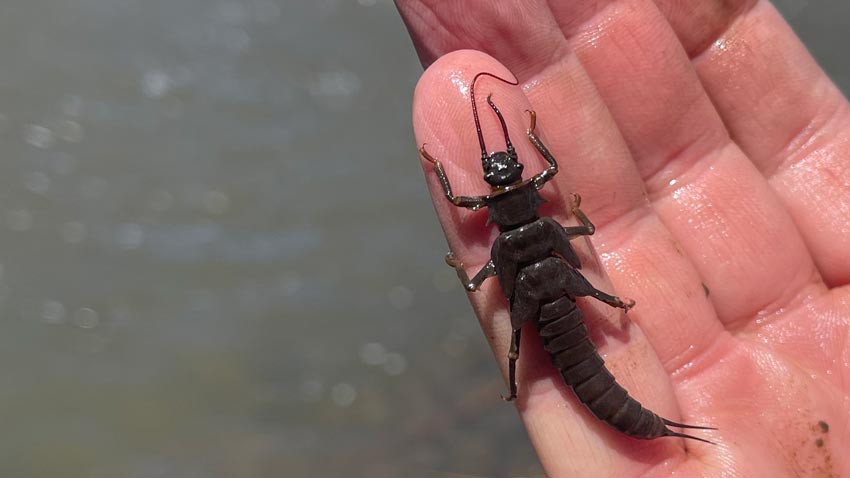The Stonefly: A Fly Fishing Essential

When it comes to fly-fishing, few insects are as iconic or as essential for anglers as the stonefly. These fascinating creatures play a crucial role in the aquatic ecosystem and are an important food source for trout, especially during high-water conditions. Understanding the lifecycle, behavior, and effective fishing techniques associated with stoneflies can significantly enhance your fishing experience. In this blog post, we’ll delve into the world of stoneflies and explore why they are a must-have in every fly-fisher's arsenal.
The Lifecycle of Stoneflies
Stoneflies are unique insects that undergo incomplete metamorphosis, which means they develop through a series of life stages: egg, nymph, and adult. Their lifecycle typically begins in the spring when adult stoneflies emerge from the water. This emergence often coincides with high-water conditions, making it the perfect time for anglers to target these insects.
Upon emerging, stoneflies crawl along the riverbed until they reach the surface, where they shed their last exoskeleton. This transformation is a critical moment, as it allows them to take flight and search for mates. After mating, the female stoneflies engage in a fascinating behavior known as “dive-bombing.” They skim the water's surface, depositing their eggs as they go, which ensures a new generation of stoneflies will thrive in the aquatic environment.
For fly anglers, understanding this lifecycle is essential. During high-water conditions, trout often seek refuge close to the banks, where the current is less intense. This is where the stoneflies are most abundant, making it an ideal feeding ground for trout. By targeting these areas, anglers can increase their chances of hooking into some impressive fish.
Fishing Techniques: The Hopper-Dropper Rig
When it comes to effectively fishing for stoneflies, one of the best strategies is to employ a hopper-dropper rig. This technique allows anglers to present two flies at once: a larger dry fly on the surface and a smaller nymph or wet fly beneath it. The combination is particularly effective during high-water conditions, as it mimics the natural behavior of stoneflies.
For the dry fly, opt for a larger pattern that resembles an adult stonefly, such as the Kaufmann's Stonefly. This fly has a realistic profile and is easy to spot on the water, making it an excellent choice for both beginners and seasoned anglers. Behind the dry fly, use a shorter dropper line (12 to 18 inches) with a smaller nymph pattern, such as a prince nymph or hare's ear. These nymphs imitate the immature stoneflies that trout are often feeding on during this time.
The beauty of the hopper-dropper rig lies in its versatility. It allows you to cover different water columns and increases your chances of enticing a strike. As you cast your rig into the water, pay attention to the movements of both flies. A subtle change in the dry fly's position can indicate a fish taking the nymph below.
Popular Stonefly Patterns
While there are countless stonefly patterns available to anglers, several stand out for their effectiveness and popularity. Here are five of the most renowned stonefly patterns that every fly-fisher should consider adding to their fly box:
- The Standard Stonefly (Kaufmann's Stonefly): This classic pattern mimics the large, dark-bodied stoneflies commonly found in many streams and rivers. Its realistic profile and visibility make it a staple for anglers targeting stoneflies.
- Pat's Rubber Legs: A simple yet effective pattern, Pat's Rubber Legs imitates the large, black, and brown stoneflies of Western rivers. With its lifelike appearance in the water and ease of tying, it has become a favorite among many anglers.
- Hopper: While not exclusively a stonefly pattern, the hopper effectively imitates various large insects, including stoneflies. Its realistic silhouette and visibility make it an excellent choice for both stillwater and river fishing.
- Chubby Chernobyl: This versatile pattern imitates a range of large insects, including stoneflies. It floats high on the water, making it an excellent option for dry fly fishing, especially when stoneflies are active.
- Stimulator: Often referred to as a "stimi," this classic dry fly pattern mimics various large insects, including stoneflies. Its bushy body and hackle create a lifelike appearance on the water, making it a favored choice among fly anglers.
Experimentation and Adaptation
The effectiveness of any stonefly pattern can vary based on the specific stream or river you are fishing, as well as the size and color of the local stonefly population. Therefore, it is essential to experiment with different patterns and techniques to discover what works best in each situation.
Consider factors such as water clarity, temperature, and the time of year when selecting your flies. Additionally, pay attention to the behavior of the fish. If they seem to be selectively feeding on a particular size or type of stonefly, adjust your rig accordingly. Stocking a variety of stonefly patterns in your fly box will ensure you are well-equipped to adapt to changing conditions.
Conclusion
The stonefly is a remarkable insect that holds a special place in the heart of fly-fishing enthusiasts. Its lifecycle, behavior, and significance as a food source for trout make it an essential target for anglers. By understanding how to effectively fish for stoneflies using techniques like the hopper-dropper rig and by utilizing popular patterns, you can elevate your fishing game and increase your chances of success on the water.
Whether you’re a seasoned angler or a newcomer to the sport, embracing the stonefly as a key component of your fly-fishing strategy will undoubtedly enhance your experience. So grab your gear, head to your favorite stream, and get ready to reel in some unforgettable memories with the stonefly!



